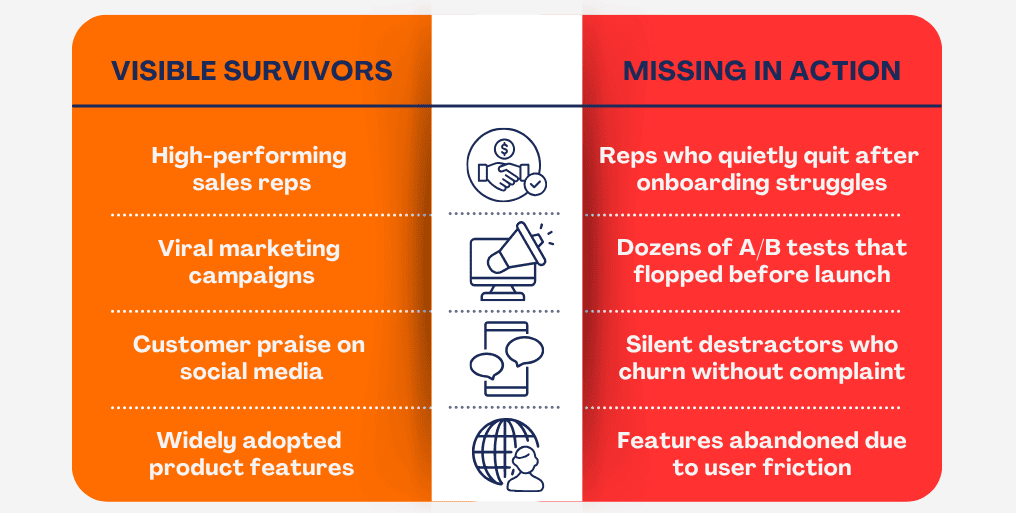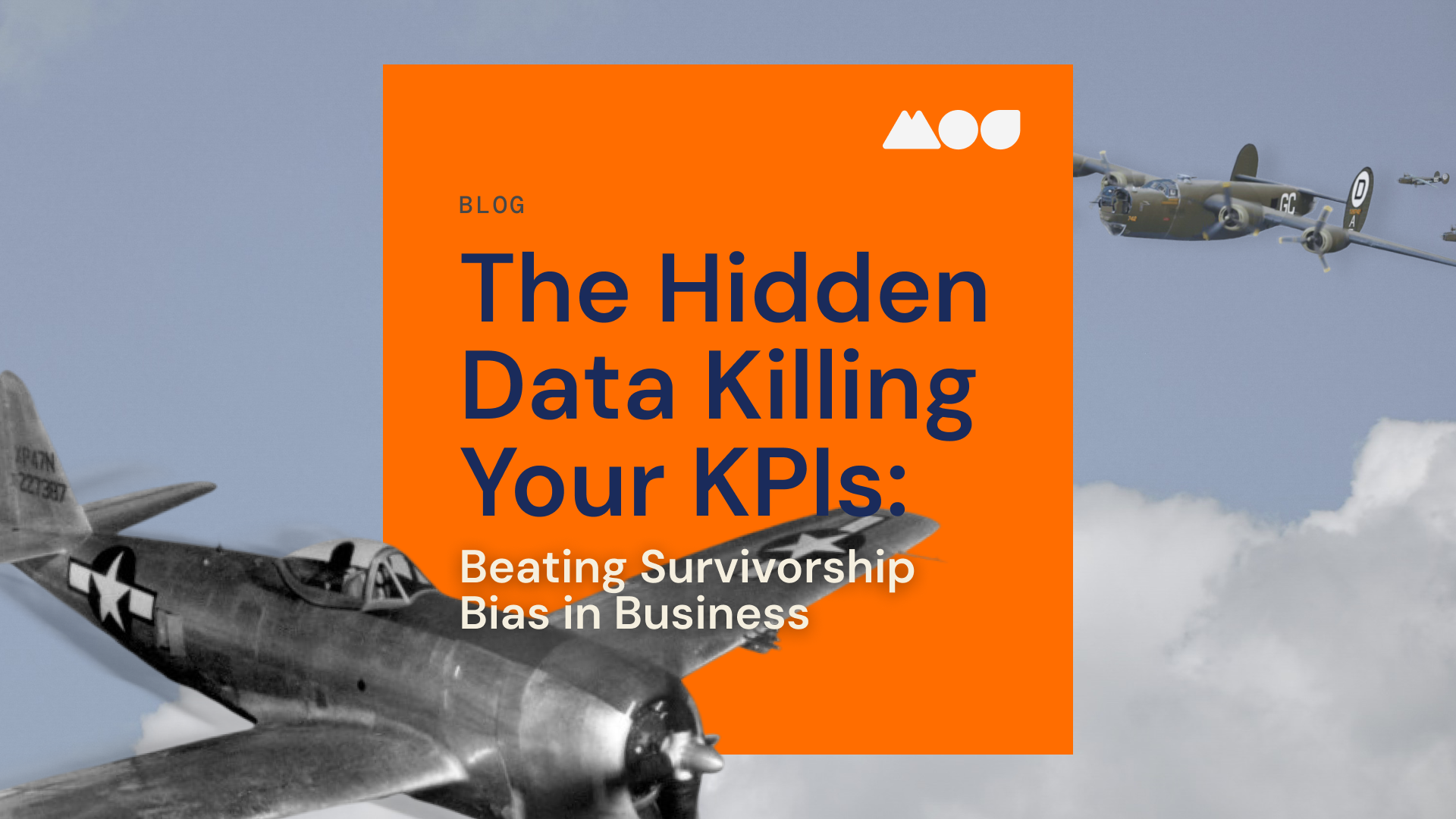If you’re the kind of leader who lives by dashboards (CMO, COO, revenue strategist, or data-driven founder), these next three minutes of reading could save you months of misfires.
Every day, your team celebrates the metrics that flash green: the campaigns that went viral, the reps who crush quota, the product that features customers rave about. But what about the projects that never shipped? The prospects who ghosted after demo day? The hires who quietly churned before their probation ended? Most dashboards don’t track what isn’t there, so your biggest blind spots remain invisible.
That hidden gap has a name: survivorship bias. It’s the same statistical trap that nearly cost the Allies their bombers in WW2. Engineers wanted to reinforce the bullet-ridden wings of returning planes, unaware that the real story lay in the aircraft that never made it home. In business terms, survivorship bias lures even the smartest operators into over-investing in the obvious “winners” while ignoring the silent data that could make or break the next quarter.
Stick with me as we unpack the history, expose where this bias hides in modern KPIs, and show how a smart layer of virtual professional talent can turn missing information into your most valuable asset.
The History Lesson
During World War II, Allied analysts mapped every bullet hole on bombers that managed to limp back to base, planning to reinforce those peppered sections of fuselage and wing. Statistician Abraham Wald flipped the insight: the damage you see only marks where planes could be hit and still survive the flight home. The truly vulnerable zones (engines, cockpits, fuel lines) were the untouched areas on returned aircraft, because planes struck there never made it back to be counted. Wald’s revelation re-allocated armor to the invisible weak points, saving countless crews and coining the classic lesson in survivorship bias: decisions based solely on visible successes ignore the silent evidence of unseen failures.
Survivorship Bias Defined (and Why It Still Costs You)
Survivorship bias occurs whenever we analyze only those options that survived a selection process and ignore the ones that didn’t. In business, that can mean:

Failing to examine the ghosts in your data leads to warped KPIs, misguided resource allocation, and costly blind spots, exactly the misfires Wald prevented.
Modern Minefields: Where Survivorship Bias Hides in Business
1. Customer Feedback Loops
Happy customers leave glowing reviews; dissatisfied ones simply disappear. If your team applauds the five-star praise but never interviews the silent leavers, retention strategies stall.
2. Recruiting & Retention Metrics
Celebrating star employees without studying high turnover roles blinds leadership to cultural or onboarding gaps. You can’t fix what you never measure.
3. Marketing Attribution
Marketers often double down on top-performing channels while discounting campaigns that never launched due to bandwidth limits. Yet those shelved ideas may have held breakthrough ROI.
4. Product Development
MVPs that reach the mark supply rich usage data, while prototypes killed in committee leave no trace. Future roadmaps then lean on a skewed sample of “proven” features.
Why Survivorship Bias Thrives in Lean Teams
Modern firms move at breakneck speed. When deadlines pile up, teams default to measuring what’s easy: the data at hand. Invisible failure points, like unconverted leads, ex-employees, or scrapped project drafts, require additional time, tools, and talent to surface.
That’s where Benevolent Leadership meets modern capacity: by extending your reach with skilled virtual professionals who hunt for the bullet holes no one else sees.
Enter the Virtual Professional: Your Data-Integrity Wingman
MyOutDesk Virtual Professionals (VPs) specialize in the granular work that uproots survivorship bias:
| VP Capability | Anti-Bias Outcome |
| Full-funnel analytics & CRM hygiene | Restores missing lead data so closed-lost opportunities inform future targeting |
| Voice-of-Customer interviews & churn surveys | Illuminates silent churn reasons, balancing the cheers with the jeers |
| Competitive & market research | Benchmarks against both thriving and failed competitors to reveal hidden pitfalls |
| Operational process audits | Tracks abandoned tasks and bottlenecks, not just completed milestones |
| A/B test management | Catalog every iteration, successful or not, to guide smarter creative bets |
Because VPs integrate seamlessly into your existing tech stack, they can chase down overlooked datasets without sinking internal bandwidth. Think of them as Abraham Wald riding shotgun in your analytics cockpit, flagging the empty spaces no report highlights on its own.
Case in Point: Closing the Feedback Gap
A SaaS firm came to MyOutDesk, celebrating a Net Promoter Score of +60. Growth had stalled, yet surveys painted a rosy picture. A VP team conducted exit interviews with churned users, revealing integration pain points that promoters had not identified. Engineering tackled the gaps, churn dropped 14%, and NPS became a predictive metric again, because negatives finally had a voice.
Building a Bias-Proof Data Culture (With Help)
- Map Your Missing Aircraft
- List business areas where only “wins” are tracked.
- Have VPs pull historical records, project archives, and churned-out data to visualize what’s invisible.
- Interrogate the Absences
- For every glowing metric, ask “Who isn’t represented?”
- Task VPs with qualitative outreach, surveys, interviews, and social listening to fill the gaps.
- Balance the Dashboard
- Present executive reports that pair success KPIs with “silent loss” indicators collected by VPs.
- Make failure data a standing agenda item.
- Iterate and Archive
- Instruct VPs to document every test or pilot, pass and fail, so the organization learns from both.
Don’t Armor the Wrong Panels
Survivorship bias is as old as warfare and as modern as your latest dashboard. Companies that armor only the bullet-riddled areas risk flying blind into tomorrow’s challenges.
With MyOutDesk Virtual Professionals digging into the data that didn’t come home, leaders gain a panoramic view of performance, victories, failures, and everything in between. That 360-degree insight is how empires (and enterprises) endure.
Ready to uncover your unseen weak points?
Schedule a complimentary Strategy Demo and let our virtual professionals ensure every decision is battle-tested before the first shot is fired.


